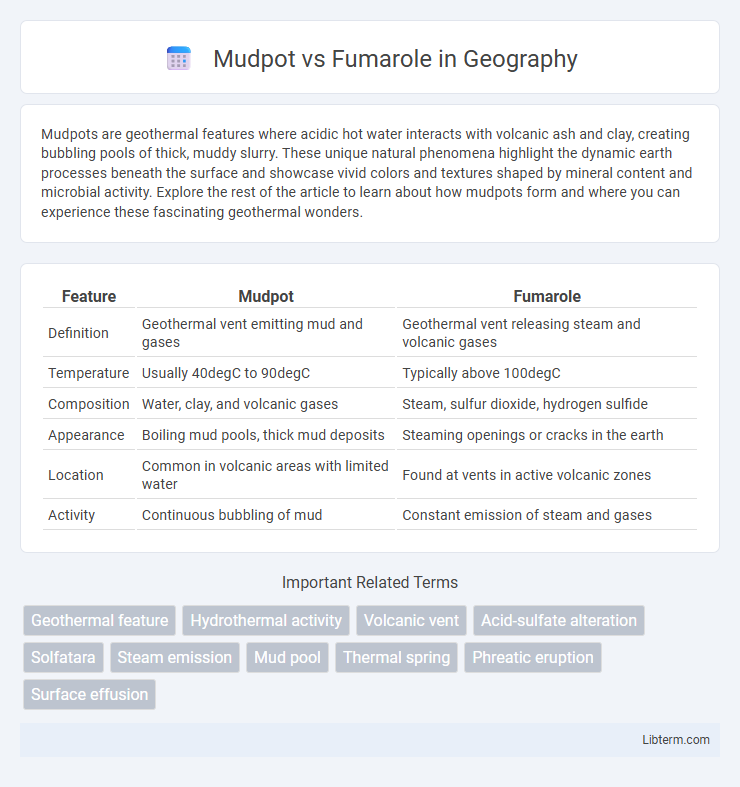Mudpots are geothermal features where acidic hot water interacts with volcanic ash and clay, creating bubbling pools of thick, muddy slurry. These unique natural phenomena highlight the dynamic earth processes beneath the surface and showcase vivid colors and textures shaped by mineral content and microbial activity. Explore the rest of the article to learn about how mudpots form and where you can experience these fascinating geothermal wonders.
Table of Comparison
| Feature | Mudpot | Fumarole |
|---|---|---|
| Definition | Geothermal vent emitting mud and gases | Geothermal vent releasing steam and volcanic gases |
| Temperature | Usually 40degC to 90degC | Typically above 100degC |
| Composition | Water, clay, and volcanic gases | Steam, sulfur dioxide, hydrogen sulfide |
| Appearance | Boiling mud pools, thick mud deposits | Steaming openings or cracks in the earth |
| Location | Common in volcanic areas with limited water | Found at vents in active volcanic zones |
| Activity | Continuous bubbling of mud | Constant emission of steam and gases |
Introduction to Mudpots and Fumaroles
Mudpots are acidic hot springs characterized by bubbling mud, formed from volcanic gases interacting with water and clay-rich soil, resulting in thick, boiling mud pools. Fumaroles are openings in the Earth's crust that emit steam and volcanic gases such as sulfur dioxide and carbon dioxide, typically found in volcanic regions with limited water supply. Both features indicate geothermal activity, but mudpots involve liquid mud while fumaroles primarily release gases.
Defining Mudpots: Formation and Characteristics
Mudpots are geothermal features formed when acidic hot water interacts with clay-rich soil, creating thick, bubbling pools of mud. These acidic conditions dissolve surrounding rock into fine sediments, producing the viscous texture and characteristic slow movement of mudpots. Unlike fumaroles, which emit steam and gases, mudpots primarily release steam through their muddy surfaces, reflecting their distinct formation and geochemical environment.
Understanding Fumaroles: Formation and Features
Fumaroles form in volcanic regions where superheated gases escape through cracks in the Earth's crust, typically reaching temperatures between 100degC and 1000degC. These vents emit steam mixed with volcanic gases like sulfur dioxide, carbon dioxide, and hydrogen sulfide, which lead to the deposition of minerals such as sulfur and silica around the vent openings. Unlike mudpots, fumaroles lack significant amounts of liquid water, resulting in dry or slightly moist gas emissions that create distinctive mineral-rich crusts and fragile, vent-related formations.
Geothermal Environments: Where Mudpots and Fumaroles Occur
Mudpots and fumaroles commonly occur in geothermal areas characterized by volcanic activity and high heat flow, such as Yellowstone National Park and Iceland. Mudpots form in acidic, water-limited environments where steam interacts with clay-rich soils, creating boiling mud pools. Fumaroles appear where volcanic gases escape through cracks, emitting steam and sulfurous vapors, often in hotter, drier zones compared to mudpots.
Chemical Processes Behind Mudpots
Mudpots form when acidic hot water interacts with volcanic ash and clay, breaking down rocks into fine particles that mix with water to create bubbling pools of mud. The chemical process involves sulfuric acid reacting with minerals, releasing gases like hydrogen sulfide and carbon dioxide, which contribute to the characteristic smell and color of mudpots. In contrast, fumaroles emit steam and volcanic gases directly through cracks without significant interaction with surface materials, resulting in less sediment accumulation.
Gas Emissions in Fumaroles
Fumaroles emit primarily sulfur-rich gases such as hydrogen sulfide (H2S), carbon dioxide (CO2), and steam, which are critical indicators of volcanic activity and gas composition in geothermal systems. These gas emissions often have high temperatures, sometimes exceeding 600degC, contributing to intense sulfuric acid formation and distinctive yellow deposits around fumarole vents. In contrast, mudpots produce lower temperature gas emissions combined with acidic hydrothermal fluids that create bubbling mud pools through the interaction of gases like carbon dioxide and water with surface sediments.
Visual Differences: How to Identify Mudpots vs Fumaroles
Mudpots display thick, bubbling pools of acidic, clay-rich water often ranging in color from gray to reddish-brown due to mineral content and sediment. Fumaroles, contrastingly, emit steam and volcanic gases through cracks in the Earth's surface, frequently accompanied by white, sulfurous deposits that create a crusty appearance around the vent. The key visual difference lies in mudpots' liquid, viscous mud consistency versus fumaroles' gaseous emissions and solid mineral deposits.
Ecological Impacts and Surrounding Life
Mudpots and fumaroles each influence their surrounding ecosystems differently due to their unique geothermal characteristics. Mudpots, with acidic, hot, and often toxic waters, create harsh environments that limit plant and animal life, favoring extremophile microorganisms adapted to acidic conditions. Fumaroles emit steam and gases like sulfur dioxide, which can alter local air quality and soil chemistry, but their less acidic nature often allows for more diverse microbial communities and some specialized vegetation to thrive nearby.
Noteworthy Locations Around the World
Noteworthy mudpots can be found in Yellowstone National Park, USA, where acidic hot springs mix with volcanic ash to create bubbling pools of mud, while California's Lassen Volcanic National Park offers prominent fumaroles emitting steam and volcanic gases. Iceland's Hverir geothermal area presents vivid mudpots alongside fumaroles, showcasing intense geothermal activity in the same region. New Zealand's Rotorua region features extensive fields of both mudpots and fumaroles, highlighting the dynamic volcanic landscape shaped by geothermal phenomena.
Conclusion: Comparing Mudpots and Fumaroles
Mudpots and fumaroles are geothermal features distinguished by their unique characteristics and formations, with mudpots exhibiting bubbling acidic mud and fumaroles emitting steam and volcanic gases. Both occur in volcanic areas with varying geothermal activity, but mudpots indicate higher water-to-gas ratios, while fumaroles reflect predominantly gaseous emissions. Understanding these differences aids in geothermal monitoring and volcanic hazard assessment, emphasizing the importance of their distinct geological and chemical signatures.
Mudpot Infographic

 libterm.com
libterm.com